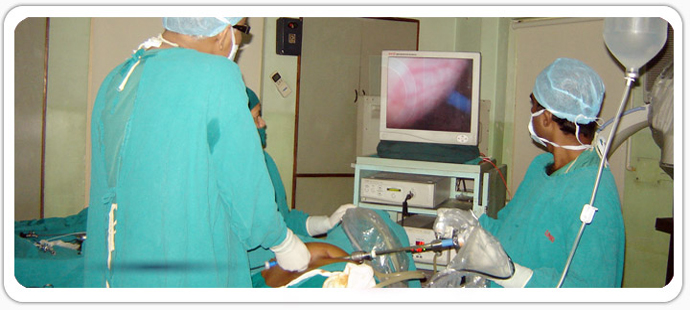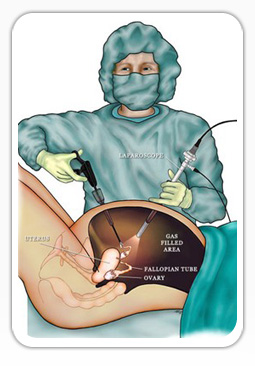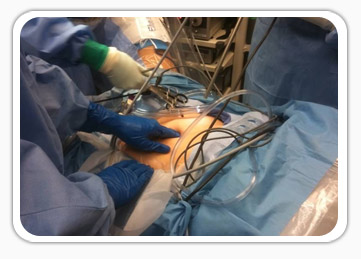Laparoscopic Surgery in Infertility



Laparoscopy is the examination and inspection of the interior of body organs or cavities using a device called an endoscope. Our unit performs all fertility promoting endoscopic procedures. Endoscopy involves laparoscopy as well as hysteroscopy.
Laparoscopy involves visualization of pelvic structures (uterus, tubes & ovaries) with the help of a special optical device called as laparoscope. Operative intervention can be done simultaneously, which helps in restoring the pelvic anatomy & improving your chance of conception.
Hysteroscopy is a surgical procedure that enables us to diagnose and operate on pathologies inside the cavity of the uterus. This consists of the introduction of an instrument with fibre optics called hysteroscope, through the cervical canal, which enables us to visualize the cavity of the uterus. We can diagnose and treat any existent uterine pathologies simultaneously.
We have state of the art, fully equipped dedicated theatres where these endoscopic procedures are performed usually as day care procedures and the patient does not need to be admitted overnight.
Laparoscopy:

(Intra abdominal 'Keyhole' Surgery)
 Laparoscopy is an operative procedure done under general anaesthesia that allows intra abdominal surgery to be performed with the help of a special optical device called laparoscope. This is inserted through a tiny incision (1) made in the abdominal wall near the navel for viewing the abdominal cavity. By introducing special instruments though additional incisions or cut over abdomen (2) it is possible to perform minimally invasive surgical procedures without the need of creating a large opening in the abdominal wall.
Laparoscopy is an operative procedure done under general anaesthesia that allows intra abdominal surgery to be performed with the help of a special optical device called laparoscope. This is inserted through a tiny incision (1) made in the abdominal wall near the navel for viewing the abdominal cavity. By introducing special instruments though additional incisions or cut over abdomen (2) it is possible to perform minimally invasive surgical procedures without the need of creating a large opening in the abdominal wall.
Why does one require laparoscopy?
Laparoscopy is an important diagnostic tool in the evaluation of an infertile patient. An inspection through the laparoscope gives us a general impression of the state of the pelvis and enables us to find the cause of infertility. Also, the tubal patency can be checked by injecting a blue dye into the uterus, through a thin tube inserted through the cervix (mouth of the uterus), and seeing it spill out though the tubes. In addition the laparoscope can also be used to safely carry out operative procedures, which enhance fertility.
Commonly done procedures by laparoscopy
Advantages of laparoscopy over open surgery
Complications of laparoscopy
Hysteroscopy

 Hysteroscopy is an operative procedure performed under general anaesthesia where a telescope is introduced into the uterus through the vagina to visualize the inside of the uterus.
Hysteroscopy is an operative procedure performed under general anaesthesia where a telescope is introduced into the uterus through the vagina to visualize the inside of the uterus.
Why does one require hysteroscopy?
Hysteroscopy is done to visualize the inside of the uterus to make sure that there are no pathologies, which could cause infertility and which if present, can be corrected simultaneously by operative hysteroscope to improve fertility.
Hysteroscopy can treat following conditions:
Complications Of Hysteroscopy
Frequently Asked Questions (FAQ'S)

Q1. What is the approximate time taken for surgery?
Ans. About 30 minutes to 1 hour depending upon nature of the surgery.
Q2.Will I need to take complete bed rest?
Ans. No, You can get up from bed and start moving about as early as 2 hours after surgery unless advised otherwise by your consultant. You can start walking, climbing stairs and can resume all basic activities on the very same day, 4-6 hours after surgery.
Q3. How soon can I start eating after the surgery?
Ans. No, You can get up from bed and start moving about as early as 2 hours after surgery unless advised otherwise by your consultant. You can start walking, climbing stairs and can resume all basic activities on the very same day, 4-6 hours after surgery.
Q4. When can I bathe after Laparoscopy?
Ans. You can bathe the day after the surgery. In case the dressing becomes wet, you can even take it off and then apply some aftershave lotion or spirit and put a band-aid on it.
Q5. Will I have any pain after surgery?
Ans. Slight pain and distension of abdomen along with shoulder pain are common after surgery. This is because, gas is filled into the abdomen to visualize the inside during surgery. However, this settles within 24 hours. You can take a pain killer whenever required. A slight pain at the stitch line may continue even up to 7 days, which is normal.
Q6. Can I have vaginal bleeding after surgery?
Ans. There may be some bleeding for a few days after hysteroscopy, which subsides on its own.
Q7. When can I get back to work?
Ans. Usually one to two days of low activity after surgery should suffice. However, follow the concerned doctor's advice.
Q8. Will I require general anesthesia & overnight stay in the hospital?
Ans. Procedures using laparoscopy are routinely performed under general anesthesia as day care cases, without the need for an overnight stay in hospital. However, prolonged laparoscopic procedures may require one or more days as an in-patient, depending on the exact nature of the procedure.